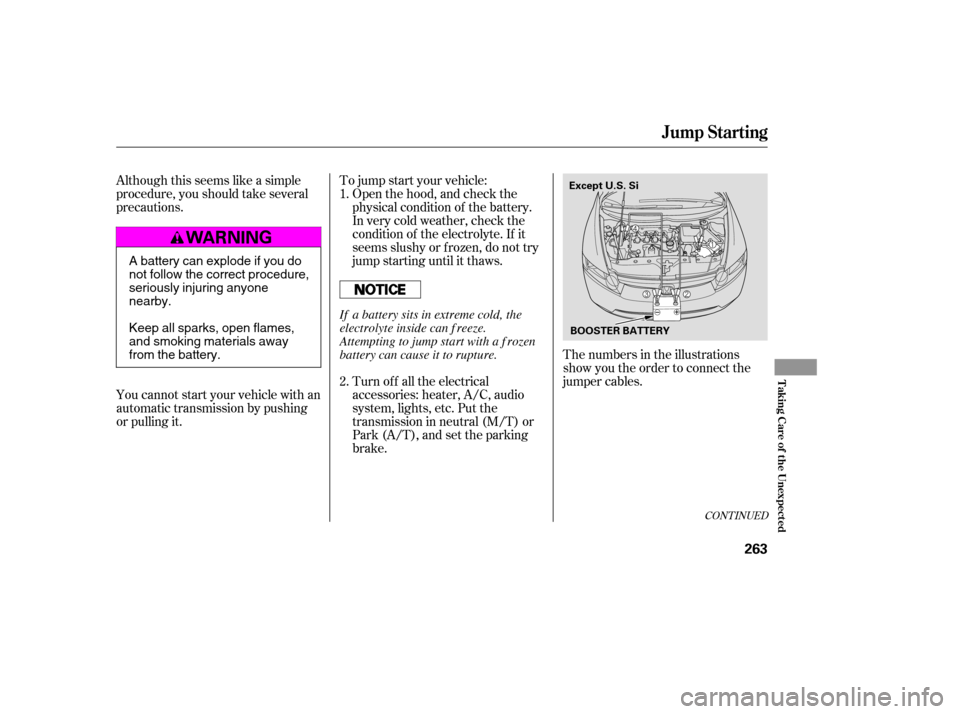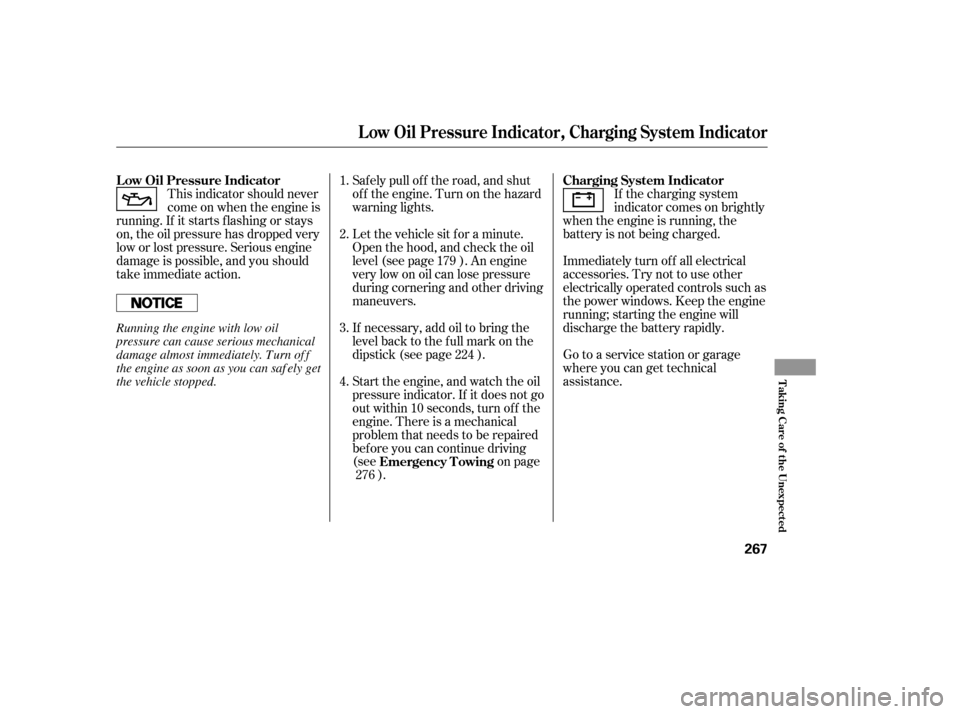Page 259 of 304

Diagnosing why the engine won’t
start f alls into two areas, depending
on what you hear when you turn the
ignition switch to the START (III)
position:When you turn the ignition switch to
the START (III) position, you do not
hear the normal noise of the engine
trying to start. You may hear a
clicking sound, a series of clicks, or
nothing at all. Turn the ignition switch to the
START (III) position. If the
headlights do not dim, check the
condition of the f uses. If the f uses
areOK,thereisprobably
something wrong with the
electrical circuit f or the ignition
switch or starter motor. You will
need a qualif ied technician to
determine the problem. See
on page .
If the headlights dim noticeably or
go out when you try to start the
engine, either the battery is
discharged or the connections are
corroded. Check the condition of
the battery and terminal connec-
tions (see page ). You can
then try jump starting the vehicle
f rom a booster battery (see page ).
You can hear the starter motor
operating normally, or the starter
motor sounds like it is spinning
f aster than normal, but the engine
does not start up and run.
You hear nothing, or almost
nothing. The engine’s starter
motor does not operate at all, or
operates very slowly.
Turn the ignition switch to the ON
(II) position. Turn on the
headlights, and check their
brightness. If the headlights are
very dim or do not come on at all,
the battery is discharged. Seeon page .
Check the transmission interlock.
If you have a manual transmission,
the clutch pedal must be pushed
all the way to the f loor or the
starter will not operate. With an
automatic transmission, it must be
in Park or neutral.
Check these things:
263 276
252
263
Nothing Happens or the Starter
Motor Operates Very Slowly
Emergency T owing
Jump Starting
If theEngineWon’tStart
T aking Care of t he Unexpect ed
261
�����—�����—�����y�
���������
���y���
�(�#�����
���y���������y
Page 261 of 304

Although this seems like a simple
procedure, you should take several
precautions.Open the hood, and check the
physical condition of the battery.
In very cold weather, check the
condition of the electrolyte. If it
seems slushy or f rozen, do not try
jump starting until it thaws.
You cannot start your vehicle with an
automatic transmission by pushing
or pulling it. To jump start your vehicle:
Turn of f all the electrical
accessories: heater, A/C, audio
system, lights, etc. Put the
transmission in neutral (M/T) or
Park (A/T), and set the parking
brake. The numbers in the illustrations
show you the order to connect the
jumper cables.
1. 2.
CONT INUED
Jump Start ing
T aking Care of t he Unexpect ed
263
BOOSTER BATTERY
Except U.S. Si
A battery can explode if you do
not follow the correct procedure,
seriously injuring anyonenearby.
Keep all sparks, open flames,
and smoking materials away
from the battery.
If a battery sits in extreme cold, the
electrolyte inside can f reeze.
Attempting to jump start with a f rozen
battery can cause it to rupture.
�����—�����—�����y�
�������������y���
�(�#�����
���y���������y
Page 265 of 304

Let the vehicle sit f or a minute.
Open the hood, and check the oil
level (see page ). An engine
very low on oil can lose pressure
during cornering and other driving
maneuvers.
If necessary, add oil to bring the
level back to the full mark on the
dipstick (see page ).
Start the engine, and watch the oil
pressure indicator. If it does not go
out within 10 seconds, turn of f the
engine. There is a mechanical
problem that needs to be repaired
bef ore you can continue driving
(see on page). Immediately turn of f all electrical
accessories. Try not to use other
electrically operated controls such as
the power windows. Keep the engine
running; starting the engine will
discharge the battery rapidly.
Go to a service station or garage
where you can get technical
assistance.
This indicator should never
come on when the engine is
running. If it starts f lashing or stays
on, the oil pressure has dropped very
low or lost pressure. Serious engine
damage is possible, and you should
take immediate action. If the charging system
indicator comes on brightly
when the engine is running, the
battery is not being charged.
Saf ely pull of f the road, and shut
of f the engine. Turn on the hazard
warning lights.
1. 2. 3. 4. 179
224
276
L ow Oil Pressure Indicator
Emergency T owingCharging System Indicator
L ow Oil Pressure Indicator, Charging System Indicator
T aking Care of t he Unexpect ed
267
Running the engine with low oil
pressure can cause serious mechanical
damage almost immediately. Turn of f
the engine as soon as you can saf ely get
the vehicle stopped.
�����—�����—�����y�
�������������y���
�(�#�����
���y���������y
Page 267 of 304

However, if the brake pedal does not
f eel normal, you should take
immediate action. A problem in one
part of the system’s dual circuit
design will still give you braking at
two wheels. You will f eel the brake
pedal go down much f arther bef ore
the vehicle begins to slow down, and
you will have to press harder on the
pedal.
Slow down by shif ting to a lower
gear, and pull to the side of the road
when it is saf e. Because of the long
distance needed to stop, it is
hazardous to drive the vehicle. You
should have it towed and repaired as
soon as possible (seeon page ).
If you must drive the vehicle a short
distance in this condition, drive
slowly and caref ully.
The brake system indicator
normally comes on when
you turn the ignition switch
to the ON (II) position and
as a reminder to check the
parking brake. It will stay
on if you do not f ully
release the parking brake.
If the brake system indicator comes
on while driving, the brake f luid level
is probably low. Press lightly on the
brake pedal to see if it f eels normal.
If it does, check the brake f luid level
thenexttimeyoustopataservice
station (see page ). If the ABS indicator comes on with
the brake system indicator, have
your vehicle inspected by your
dealer immediately.
If the f luid level is low, take your
vehicle to a dealer, and have the
brake system inspected f or leaks or
worn brake pads. 234
276Emergency
Towing
Brake System Indicator
T aking Care of t he Unexpect ed
269
Canada U.S.
�����—�����—�����y�
���������
���y���
�(�#�����
���y���������y
Page 269 of 304
Turn the ignition switch to the
LOCK (0) position. Make sure the
headlights and all other
accessories are of f .
Remove the cover f rom the f use
box.Check the smaller f uses in the
under-hood f use box and all the
fuses in the interior fuse box by
pulling out each one with the f use
pullerprovidedonthebackof the
under-hood f use box cover.
Check each of the large f uses in
the under-hood f use box by
looking through the top at the wire
inside. Removing these f uses
requires a Phillips-head screw-
driver.
1. 2. 3.
4.
CONT INUED
Fuses
T aking Care of t he Unexpect ed
271
FUSE PULLER
BLOWN
FUSE
BLOWN
�����—�����—�����y�
�������������y���
�(�#�����
���y���������y
Page 272 of 304
�Î
�Î �Î
�µ �µ �µ �µ
No.
No. Circuits Protected Amps. Circuits Protected
Amps.
45 67 8 9
1011121314151617181920212223
1 23 Main Fuse EPS
Option Main
Ignition Switch Main
ABS/VSA Motor
ABS/VSA F/S 50 A
40 A
20 A
20 A
30 A
30 A
40 A
10 A
15 A
15 A
7.5 A 15 A
15 A
15 A
7.5 A 15 A
7.5 A 10 A Headlight Main
Power Window Main
Not Used
Sub Fan Motor
Main Fan Motor (M/T)
Main Fan Motor (A/T)
Rear Defogger
Blower
Hazard
FI Sub
Stop and Horn
Not Used
Not Used
IGPS Oil Level
Not Used
Audio Amp
IG Coil
FI Main
MG Clutch
DBW
Interior Light
Back Up
100 A
70 A
80 A
50 A
30 A
30 A
40 A : U.S. Si model
Fuse Locations
274
UNDER-HOOD FUSE BOX
�����—�����—�����y�
�������������y���
�(�#�����
���y���������y
Page 273 of 304

�µ �µ�µ�µ �µ �µ �µ
�Î
�Î �Î
�Î
�Î
�Î
No. No.No.
Amps. Circuits Protected
Amps. Circuits Protected
Amps.
Circuits Protected :
1 23456789
10111213141516 17181920212223242526272829303132333435363738
7.5 A
7.5 A
10 A
10 A
10 A
7.5 A
7.5 A 10 A ODS
MET ER
SRS
Right Headlight High
Left Headlight High
Small (Interior)
Small (Exterior)
Right Headlight Low
7.5 A
15 A
10 A
7.5 A
(15 A) Left Headlight Low
Headlight High Main
Small (Main)
Not Used
Headlight Low Main
(HAC)
STS
Moonroof
Door Lock
Driver’s Power Window
Not Used
Rear ACC Socket
ACC
Passenger’s Power Window
Not Used
Right Rear Power Window
Left Rear Power Window
Not Used
ACC Radio
HAC
Daytime Running Light
Wiper
10 A
20 A
15 A
20 A
(7.5 A)
(7.5 A)
(20 A) 20 A
20 A
(15 A) 15 A
20 A
20 A
20 A
7.5 A 10 A
7.5 A 30 A
Power Window
Fuel Pump
Alternator
ABS/VSA
Heated Seat
Not Used
Not Used
Not Used
If equipped
Fuse Locations
T aking Care of t he Unexpect ed
275
INTERIOR FUSE BOX
�����—�����—�����y�
�������������y���
�(�#�����
���y���������y
Page 280 of 304

�µ�µ�µ
�µ �µ�µ �µ �µ�µ�µ�µ�µ�µ�µ�µ�µ
�Î�Î�Î�Î�Î�Î
�µ�µ�µ�µ�µ
�Î
�Î �Î
�Î�Î �Î �Î
�Î
�Î
�Î
Specif icat ions
Technical Inf ormation
283
Air Conditioning
Fuses
Alignment
Lights Battery Tires
HFC-134a (R-134a)
14.1 15.9 oz (400 450 g)
SP-10
12 V 60 W (HB3)
7°24’1°30’
0°
0.00 in (0.0 mm)
P195/65R15 89H 0.08 in (2.0 mm)
Refrigerant type
Charge quantity
Lubricant oil type
Interior
Under-hood
Toe-in
CamberCaster
12 V
12 V
12 V
12 V
12 V
12 V
12 V
12 V
8W
5W
21 W
3CP
21 W
21/5 W
21 W
21/5 W
12 V 51 W (HB4)
12 V 2 CP
12 V 8 W
12 V 5 W P205/55R16 89H
Headlights
Front turn signal/side marker/
Parking lights
Rear turn signal lights
Stop/Taillights
Rear side marker lights
Back-up lights
Taillights
High-mount brake light
License plate lights
Ceiling light
Spotlights
Trunk light
Capacity
60 psi (420 kPa , 4.2 kgf/cm
)
30 psi (210 kPa , 2.1 kgf/cm
)
32 psi (220 kPa , 2.2 kgf/cm)
T125/70D15 95M
12 V
12 V
12 V
12 V 36 AH/5 HR
45 AH/20 HR
38 AH/5 HR
45 AH/20 HR Size
Pressure
12 V 47 AH/20 HR P215/45R17 87V
215/45R17 91W
T125/70D16 96M
32 psi (220 kPa , 2.2 kgf/cm)
29 psi (200 kPa , 2.0 kgf/cm)
See page 275 or the fuse label
attached to the inside of the fuse
box door under the steering
column.
See page 274 or the fuse box
cover.
HighLow
FrontRear
FrontRear
Front
1:2:3: LX, EX
DX, Canadian DX-G
U.S.Si(allseasontires) 4:5:6:
Except U.S. Si
Optional for U.S. Si (summer tires)
U.S. Si
U.S.
Vehicles
Canada
Vehicles Front/Rear
Spare
Front/Rear
Front Rear
Spare
3
3 3
12 4 6
1
2
5
�����—�����—�����y�
���������
���y���
�(�#�����
���y���������y